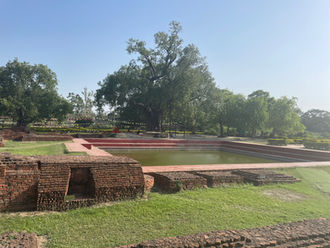
LUMBINI MAYADEVI TEMPLE Ashok Edict
Lumbini, located in the southern part of Nepal, is an integral part of the Tarai region, known as the birthplace of Gautam Buddha. Lumbini is one of the four most sacred pilgrimage sites in Buddhism, along with Bodh Gaya, Sarnath, and Kushinagar. It was declared a UNESCO World Heritage site in 1997. Lumbini lies in the Rupandehi district, named after the Rupandevi Temple, where the queen Mayadevi gave birth to Buddha. The temple was built right next to a sacred pond and garden. As the legend goes, the beautiful garden of Lumbini attracted Queen Mayadevi to rest there while on her way to Kapilvastu, her maternal home. Hence, to preserve the sacredness of the birthplace of Buddha, the Mayadevi Temple was built in 249 B.C. during the visit of Emperor Ashoka. Later, Ashoka raised a pillar at the spot of the birthplace of the Buddha engraved with instructions on the practical pursuit of good religion using Dhaṃma Lipi ("Inscriptions of the Dharma") along with 16 stupas.
After the 14th AD, Lumbini was lost in the jungle for 500 years until 1896, when German archeologists started the search for the Mayadevi temple and found the Ashoka Pillar, which had an inscription identifying the exact birthplace of Buddha. In 1899, Indian archeologists found an ancient statue of Buddha. As the United Nations started taking an interest in the development of Lumbini around 1968, multiple proposals were invited out of which Japanese architect Kenzo Tange's proposal was accepted in 1972. Kenzo Tange proposed a modern master plan by creating a grid of 80x80m, with multiple activities designed and executed to develop it as an international pilgrimage and tourist center. In the 1990s, a marker stone that bears the footsteps of Buddha was found, believed to be a major archaeological evidence of the place of birth. In 2010, archeologists found human skulls, an iron sickle, and a few bones of birds and animals that represent a human settlement of hunters and gatherers around the pre-Buddhist era.
The master plan included the central circle that comprises the Mayadevi temple, the sacred garden, and the archaeological ruins of monasteries and the temple. The new Mayadevi temple was built on the ruins of the old temple, and there is a wooden walkway that goes around the other ruins, most of which date back to the Gupta period (5th-6th CE.) The temple has a lot of stupas in the vicinity, but the most interesting ones are a set of 16 stupas built on one square base.
Lumbini, and specifically the Mayadevi Temple has a long history spanning different eras and dynasties. Every era had its version of preserving and developing the area, but its significance is preserved through oral histories and archaeological evidence found amongst the ruins.
Kenzo Tange’s design, much like the modern plan of Chandigarh by Corbusier, creates large out of scale sprawled out spaces, where people are made to walk in the scorching heat of the Terai plateau. This spatial configuration is far removed from the dense and active public space of the Durbar Squares of Patan, Kathmandu or Bhaktapur.

Mayadevi Temple, with the ruins of the monasteries in the front
(Source: Rupali Gupte)

Ashoka Pillar
(Source: Rupali Gupte)

Temples built right in front of the Royal Palace
(Source: Rupali Gupte)
References:
-
Archeolog-Home. n.d. “Unearthed:Pre Ashoka structure.” http://www.archeolog-home.com/pages/content/lumbini-nepal-unearthed-pre-ashoka-structures.html
-
Banerjee, N.R. 2019. Nepalese Architecture. Second Edition ed. Delhi, India: Dr.Agam Prasad,M.A.,Ph.D.,Diploma in Museology.
-
Giri, Gitu. 2003. Art and Architecture Remains in the Western Terai Region of Nepal. Delhi, India: Adroit Publishers.
-
Goyal, Anuradha. n.d. “Lumbini Garden-Where Mayadevi gave birth to Buddha.” Indiatales-The travel blog of India. Accessed March 9, 2017. https://www.inditales.com/buddha-birthplace-lumbini-garden-nepal/
-
Ministry of Industry, Forest and Environment. n.d. Lumbini visitor guide. Butwal, Nepal: Ministry of Industry, Forest and Environment. https://moitfe.lumbini.gov.np/media/publications/Lumbini_Visitor_Guide_Book.pdf
-
Rai, Durga, and Priyanka Karn. 2023. “Conservation study of Maya Devi temple and Keshav Narayan Chowk by Priyanka Karn and Durga Rai.” SlideShare. https://www.slideshare.net/slideshow/conservation-study-of-maya-devi-temple-and-keshav-narayan-chowk-by-priyanka-karn-and-durga-rai/261530000
-
Tiwari, Sudarshan R. n.d. “Mayadevi Temple.” Accessed April, 1995. http://www.kailashkut.com/wp-content/uploads/2016/05/mayadevitemple.pdf
DRAWINGS






